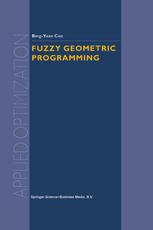

Most ebook files are in PDF format, so you can easily read them using various software such as Foxit Reader or directly on the Google Chrome browser.
Some ebook files are released by publishers in other formats such as .awz, .mobi, .epub, .fb2, etc. You may need to install specific software to read these formats on mobile/PC, such as Calibre.
Please read the tutorial at this link: https://ebookbell.com/faq
We offer FREE conversion to the popular formats you request; however, this may take some time. Therefore, right after payment, please email us, and we will try to provide the service as quickly as possible.
For some exceptional file formats or broken links (if any), please refrain from opening any disputes. Instead, email us first, and we will try to assist within a maximum of 6 hours.
EbookBell Team

4.0
36 reviewsFuzzy geometric programming was originated by the author in the Proceed ing of the second IFSA conferences, 1987(Tokyo) 14 years ago. Later, the paper was invited for formal publication in the International Journal of Fuzzy Sets and Systems. From then on, more and more papers have been written by scholars all over the world who have been interested in its research. So this programming method has been acknowledged by experts and has gradually formed a new branch of fuzzy mathematics. lnspired by Zadeh's fuzzy sets theory, fuzzy geometric programming emerges from the combination of fuzzy sets theory with geometric programming, where models are built in the fuzzy posynomial and the reverse geometric program ming. The present book is intended to discuss fuzziness of objective function and constraint conditions, a variety of fuzzy numbers in coefficients and vari ables and problems about multi-objective fuzzy geometric programming. It establishes and rounds out an entire theory system, showing that there exist conditions of fuzzy optimal or most satisfactory solutions in fuzzy geometric ptogramming, and it develops some effective algorithms. In order to introduce this new branch, the book aims at the exposition of three points: encompassing ideas and conception, theory and methods, and diffusion and application. lt lays more emphasis on the second point than the first one, and less on the third. Besides, it introduces some knowledge of classical geometric programming and of fuzzy sets theory and application examples of fuzzy geometric programming in electric power systems as weil.